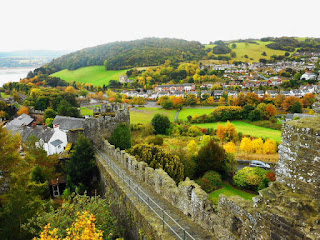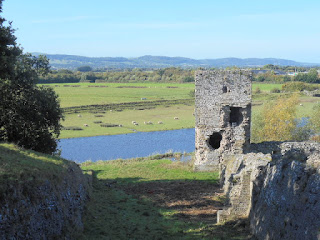In which I cross another of those 427 Welsh castles off my list - but unfortunately don't get to meet the princess who haunts it.
As much as I love living in Wales the default weather setting is usually wet and windy, so when we had a blast of unseasonal hot and sunny weather in September, I decided to get out and explore. (Translation: stand by for a lot of castle-themed blog posts!)
This is Rhuddlan Castle, located next to the River Clwyd in Denbighshire. The name means 'red bank', from the colour of the riverside soil, and there has been a settlement here for many centuries.
 |
Rhuddlan Castle
(the west gate house) |
The River Clwyd and its surrounding marshes created a natural barrier to anyone wanting to invade Wales. As this was the best place to cross, it was an important position strategically. King Alfred's son, Edward the Elder, established an earth and timber fort at the mouth of the Clwyd as part of his defence against Scandinavian raids. And in 1063 it was also the base from which Gruffydd ap Llywelyn carried out his raids on England, before having his palace burned from under him by Harold II (the last Anglo-Saxon king of England, who lost his throne to William the Conqueror at the Battle of Hastings).
 |
| The River Clwyd |
It was William the Conqueror who commanded Robert of Rhuddlan to build a motte-and-bailey castle on the old site of Gruffydd's palace in 1073. Known as Twthill (lookout hill), the remains of this Norman fortress can still be seen as a great earthen mound close to Rhuddlan Castle. At the base of the mound would have been the original Norman town; it even had its own priory.
 |
Twthill: The remains of a Norman fortress
(There would have been a wooden tower on top)
|
Two hundred years later, King Edward I chose this area to build Rhuddlan Castle, which became the base for his invasion of Wales in 1282. It was built at the same time as Flint Castle (which I've blogged about here) by James of St George, an architect from Savoy, who was also responsible for designing many of Edward I's other castles, including Caernarvon, Conwy and Beaumaris. As well as the castle, a new town was also created.
|
|
The Inner Ward
(looking back at the west gate house) |
 |
| The remains of the north tower |
While the castle was still under construction, over 70 labourers were employed to straighten the River Clwyd, and deepen its channel, providing a way for Edward's ships to keep the castle supplied. At high tide the lower part of the castle moat would flood, forming a dock protected by Gillot's Tower (possibly named after Gillot de Chalons, one of the masons). The remains of the river gate can still be seen within the walls of the castle.
 |
| Access to the dry moat |
|
|
The Dock, guarded by Gillot's Tower
|
|
|
Gillot's Tower gave protection to the castle's supply ships
approaching from the River Clwyd |
According to legend it was at Rhuddlan, not at Caernarfon, that Edward proclaimed his son the first English Prince of Wales. And his youngest daughter, Elizabeth, was born here. Edward's wife, Eleanor of Castile, had a lawn laid out in the inner ward, as well as a small fishpond, and there were seats around the well for her and her ladies to sit.
The castle was attacked by Madog ap Llywelyn in 1294 and again in 1400 by the followers of Owain Glyndŵr. Although the castle didn't fall on either occasion, the town was badly damaged.
|
|
Gillot's Tower and the River Clwyd
(taken from the west gate house)
|
During the English Civil War, Rhuddlan Castle was garrisoned by Royalist troops but taken by the Parliamentarians following a siege in 1646. Two years later, the castle was partially demolished (like Flint Castle) to prevent further military use.
The Knight of the Blood-Red Plume
Any ancient building has to have a ghost, although the headless man or a grey lady have become a bit of a cliché. The ghosts associated with Rhuddlan Castle are a little bit more ... unusual - and possibly not all they seem!
 |
An illustration from
The Knight of the Blood-red Plume |
According to legend, Rhuddlan Castle was once home to the fair Erilda. Her father had fought alongside Bleddyn ap Cynfyn (the successor to Gruffydd ap Llywelyn and an ally to Harold II). Unknown to her, she had been promised in marriage to Bleddyn's son, Morven. Erilda was beautiful and kind, and loved by all who knew her. One day she became lost in the mist on the marshes and was rescued by a mysterious knight by the name of Wertwrold. He was handsome and brooding, with black hair and black eyes, even his clothes were black - except for a blood-red feather. Erilda's father was so grateful, he asked the strange knight to stay with them at the castle. The knight agreed to delay his journey but, despite various sports being arranged for his amusement, he remained pale and melancholy - and so of course Erilda fell madly in love with him. It was then she learned of her betrothal to Prince Morven.
Being a dutiful daughter, at first Erilda went ahead with the marriage preparations, but then she could bear it no longer and begged Wertwrold to elope with her. Wertwrold agreed, but only if she would swear to be his and his alone, regardless of what her father might do or say. Erilda agreed and they fled the castle, pursued by her father's soldiers. As the men drew closer, Wertwrold gave Erilda a dagger to defend herself but, just as they were in sight of the boat that was to take them to safety, someone grabbed her robe. Erilda spun around and stabbed them with the dagger - only to discover she had killed her own father.
Erilda was distraught but Wertwrold only laughed. He admitted he'd deliberately seduced her so she wouldn't marry Prince Morven. The marriage would have restored Wales to prosperity and peace, and he wanted to start a war. Wertwrold then revealed his true form, that of a water demon who lived beneath the waves of the River Clwyd, and stabbed Erilda with a trident.
Since that night, Erilda has been doomed to haunt Rhuddlan Castle in her blood-stained gown, screaming as she's pursued through the ruins by the knight of the blood-red plume.
Isn't that deliciously gothic? OK, maybe a little bit too gothic.
First, the dates don't match up. At the time Wertwrold was wooing Erilda, Rhuddlan Castle hadn't been built and Gruffydd's palace had just been burned. Also, Wertwrold is a Saxon name. The Saxons wouldn't want a united Wales, so while having one of their agents prevent the marriage of one of the Welsh princes sounds plausible, having him turn into a scaly river demon? Not so much!
 |
Ann Julia Hatton (nee Kemble) (1764-1838)
aka Ann of Swansea
by Willliam Watkeys
(Wiki Commons) |
A version of the story appears as The Legend of the Knight of the Blood-Red Plume in Welsh Legends: a collection of popular oral tales edited by William Earle and published in 1802. The same story has also been attributed to Ann Julia Hatton (sister of the famous actress, Sarah Siddons), who wrote under the pen name 'Ann of Swansea'. Her version was published by the Minerva Press in 1826 but she may have also written the earlier one anonymously.
This kind of gothic tale was extremely popular in the late 18th and early 19th century - bloodthirsty, melodramatic - and with a very strong moral. This one apparently being, 'See what happens when you don't do as you're told!'
Which is a shame, for I quite like the idea of the fair Erilda running away with the broodingly handsome Wertwrold and living happily ever after.
Although if I were writing their story, I'd definitely change his name!
Rhuddlan Castle is managed by Cadw. Their official website is here.
If you're interested, you can read the entire William Earle version of The Knight of the Blood-Red Plume online here (Internet Archive). But I warn you, it is very gothic!
Never miss a post! See that little box in the left-hand column, near the top, that says 'Follow by Email'? If you add your email address, you'll receive my latest blog post almost as soon as I've written it.
Related Posts:














































